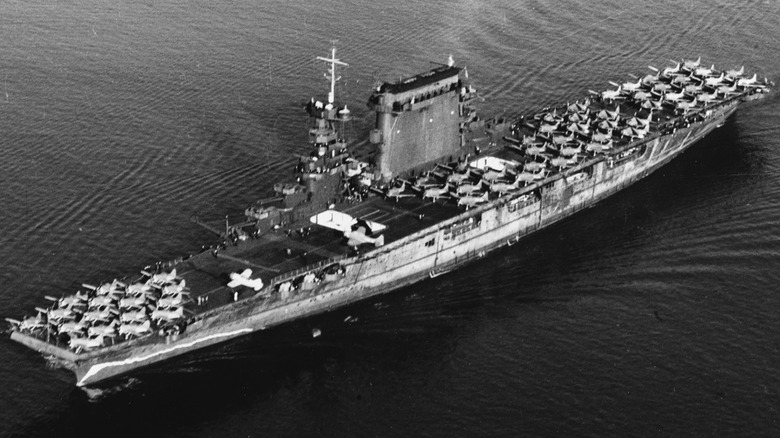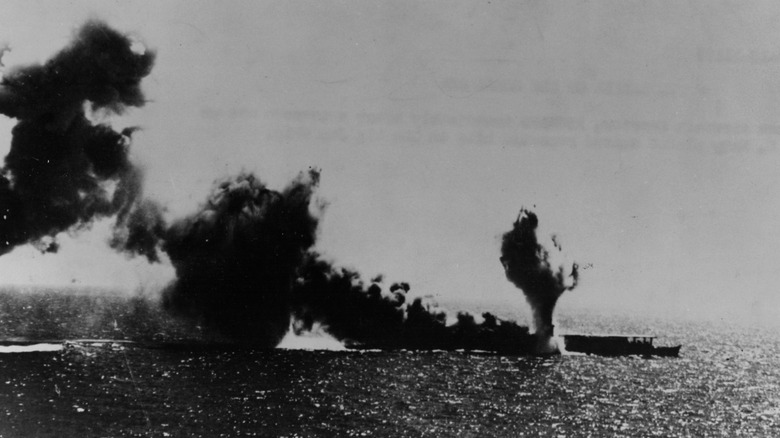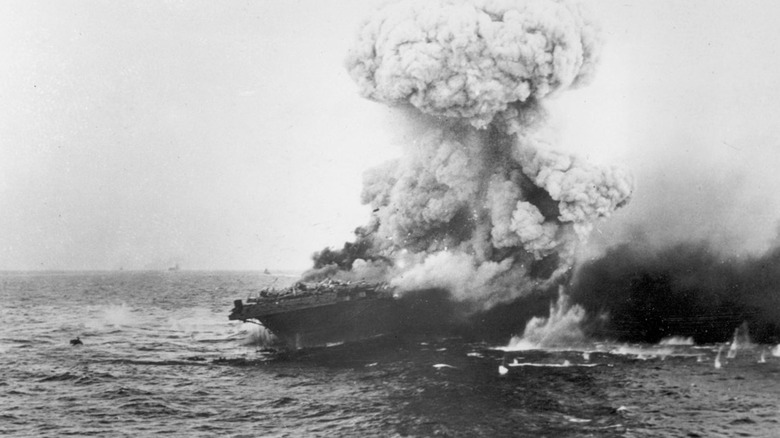What Was The First Military Battle Between Aircraft Carriers?
The world's navies have been using aircraft carriers since 1918, but it wasn't until World War II that the powerful vessels came into their own. Before carriers, navies revolved around battleships, which served throughout WWII. When the U.S. lost much of its battleship strength in the Pacific Fleet, things changed. The attack on Pearl Harbor altered U.S. naval strategy, and the carriers that weren't at Pearl Harbor during the sneak attack formed the core strength of the fleet for the remainder of WWII.
Aircraft carriers saw naval warfare take to the skies, and they participated in many battles, with losses on both sides. Given how important they were, it's interesting to explore the first time two carriers met one another in combat. That hadn't happened before WWII, but when it did, it effectively changed naval warfare forever. A carrier provided the ability for warships to engage in over-the-horizon combat. Essentially, a carrier doesn't need to see its target to engage it — that's what its air force is for.
The first time aircraft carriers on opposing sides engaged in combat was in May 1942, during the Battle of the Coral Sea. The battle took place between May 4 and 8 and was a watershed moment in naval warfare, and it was an important conflict for the U.S. Navy. The Navy lost much of its combat power at Pearl Harbor, and the Battle of the Coral Sea offered two things. It demonstrated the combat effectiveness of carriers in blue-water warfare, and it gave the Americans an opportunity to regain a foothold in the Pacific.
[Featured image by U.S. Navy via Wikimedia Commons | Cropped and scaled | Public Domain]
Battle of the Coral Sea: May 4 - 7
On May 4, 1941, two U.S. carrier task forces were dispatched in an effort to stop Japanese advancements in New Guinea and the Solomon Islands. Japan learned of two U.S. carriers in the area, diverting their attention from their operation to engage the new threat. By nightfall of May 6, the fleet carriers, USS Lexington (CV-2) and USS Yorktown (CV-5), attempted to find the Japanese fleet carriers, the Zuikaku and Shōkaku, but neither side could locate the other in the darkness despite being relatively close.
The next day, the search resumed, and both sides launched attacks on the other. Over-the-horizon combat was established for the first time, but not without problems. Both the Japanese and Americans engaged different targets by mistake, though the Americans had more luck. Fifty aircraft from the Lexington and 43 from the Yorktown happened upon a new light carrier, Shōhō. While it wasn't the fleet carriers the American scouts previously identified, it was also a sitting duck.
The aircraft made short work of the Shōhō, sending her beneath the waves with multiple torpedo and bomb strikes. Meanwhile, the Japanese also misidentified its targets, and while the Zuikaku and Shōkaku set out to attack a fleet, they found only a fast fleet oiler, Neosho, and an escort destroyer, Sims. The Japanese aircraft engaged both targets, immediately sinking the Sims; though the Neosho remained afloat, she was effectively dead in the water, having taken a great deal of damage. Over-the-horizon proved successful for both sides, but not in the way they intended.
[Featured image by U.S. Navy via Wikimedia Commons | Cropped and scaled | Public Domain]
Battle of the Coral Sea: May 8
Finally, on May 8, the larger fleet carrier Shōkaku met the Lexington and Yorktown in over-the-horizon combat, resulting in a massive air battle. Both U.S. ships were equipped with radar, while the Japanese vessel wasn't. This gave the Americans an edge in launching their aircraft, 75 of which went up to engage the 69 later launched by the Japanese. All three carriers came under attack from aircraft launched by the other sides, and it was a brutal fight resulting in numerous losses across the board.
The Americans lost a total of 66 aircraft, while Japan lost 77. The carriers didn't fare well from the battle on either side, as the aircraft carrier Lexington was damaged so badly it had to be scuttled, joining the list of sunken U.S. Navy ships. Additional losses for the Americans included a destroyer, an oiler, and plenty of damage to the USS Yorktown, which needed significant repairs. The Japanese lost the Shōhō and suffered critical damage to the Shōkaku, which took three 1,000 lb. bomb strikes on her flight deck.
Both the Shōkaku and Zuikaku lost so many aircraft that they were no longer combat-capable and couldn't take part in the Battle of Midway in June. The Imperial Japanese Navy also lost a destroyer, three minesweepers, and more. Ultimately, the Battle of the Coral Sea was a strategic victory for the Allies, and it resulted in a severe degradation of combat effectiveness for the Japanese. Most importantly, the battle halted possible Japanese plans to invade Australia.
[Featured image by U.S. Navy via Wikimedia Commons | Cropped and scaled | Public Domain]


